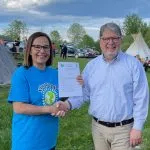
Indigenous scientist and business owner is focused on clean water and curriculum development
To say science is a passion would be an understatement for Dawn Pratt.
The chemist turned business owner is determined to bridge the gap between traditional knowledge and Western science.
Pratt, from the Muscowpetung Saulteaux Nation, holds a Master of Science in physical chemistry from the University of Saskatchewan and, in 2020, she launched her company Askenootow STEM (Science, Technology, Engineering & Mathematics) Enterprise Inc.
“[Indigenous people] are the original inhabitants, the original entrepreneurs and the original innovators,” said Pratt. “Naturally, we are the original scientists – we based our knowledge and teachings purely on observation and experiences.”
She is using her science education to Indigenize curriculum, which is the foundation for her business. Using the innovations of modern science and technology, she can generate a bridge of understanding to connect ideas from completely different areas of knowledge and understanding.
Through her different roles, Pratt advocates for the inclusion of Indigenous language and the validation of the Knowledge Keepers’ interpretation of traditional concepts.
The work she completed for her Master of Science in Physical Chemistry from the University of Saskatchewan has been reviewed by several peers.
Pratt has also been featured in the American Chemical Society News for her quest for mainstream and Western academia to recognize innovative Indigenous creations because they can be quantified. Some ancient ways of doing things still exist today, which proves the old techniques can’t be improved upon.
Her unique research also attracts international interest. This has resulted in invitations to present and share her knowledge with other scientists and educators. Pratt uses common Indigenous structures like the teepee or canoe and then explains the science behind why they work to validate traditional knowledge.
Indigenous contributions to science have been largely overlooked, but she wants to change that misconception.
Although she’s working to build her business by highlighting Indigenous contributions to science and finding ways to include that information in curriculum, she remains a scientist at heart.
Her primary research involves finding a way to extract arsenic from water supplies.
She said Indigenous people are often called the traditional stewards of the land, which is something she takes seriously.
It’s no surprise Pratt is looking for a solution to purify contaminated water.
As an Indigenous person and scientist, she knows without water there is no life, so she is using both her Western education and traditional teachings to find a solution to heal the water.
Pratt has spent her educational and professional life working alongside educators and scientists, advocating for the inclusion and recognition of Indigenous technology and science.
It may be an uphill battle to Indigenize the fields of Science, Technology, Engineering and Mathematics, but it’s a goal she continues to work towards.
One of the ways Pratt does this is to look at Indigenous practices and construct and earmark them for concrete ideas and information that can be interpreted and deconstructed from an Indigenous perspective.
Pratt hopes the work she does today will help to encourage other Indigenous youth to pursue a career in science because, historically, Indigenous people have a history of being problem solvers.

